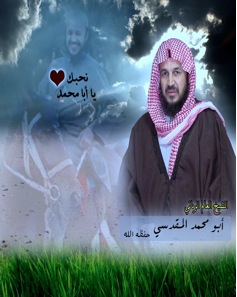
The image includes two pictures of Abu Muhammad al-Maqdisi, a Jordanian-Palestinian ideologue who served as spiritual mentor to Abu Mus‘ab al-Zarqawi. The caption on the left reads: “nuhibbak ya Aba Muhammad” (“we love you Abu Muhammad”). This sentiment is further expressed by the big red haloed heart. Under the picture on the right appear the figure’s name and titles, and a traditional prayer for the living: “al-shaykh al-‘alim al-rabbani abu muhammad al-maqdisi, hafizahu allah” (“the shaykh, divine scholar, Abu Muhammad al-Maqdisi, may God keep him safe”).
The use of traditional jihadi elements in the image–including the horse, the greenery and the clouds–help emphasize the figure’s status as a cherished leader, his purity and personal religious piety, as well as the positive light in which his actions/words are seen within the broader Muslim society. The horse is an important symbol in both pre-Islamic Arabia and Islamic culture, as evidenced by pre-Islamic poetry, hadiths (prophetic traditions or reports) and other genres of literature ascribing horses with the positive qualities of chivalry and bravery in battle. For example, the beginning of the Qur’anic sura 100 talks about “running horses” that appear as galloping through the world toward the final goal, namely, Judgment Day. Horses are also symbolic of the first generation of Muslims and that generation’s successful military campaigns, and thus are often employed to evoke specific Salafi religious sentiments with regard to the military victories of Muhammad and his companions. The rider emphasizes the element of human agency in jihad, and is a way to enhance the traditional symbol of a horse and flesh out notions of aggression and the call to jihad. Thus, the horse and rider motif places current jihadi activities within the same unfolding dialectic as the jihad of early Islam.
 Skip to content
Skip to content
